The impact of COVID-19 on women scientists from developing countries: Results from an OWSD member survey
In June 2020, OWSD surveyed our network of women scientists living and working in the developing world about the effects of the COVID-19 pandemic on themselves and their research. Here are some of the results.

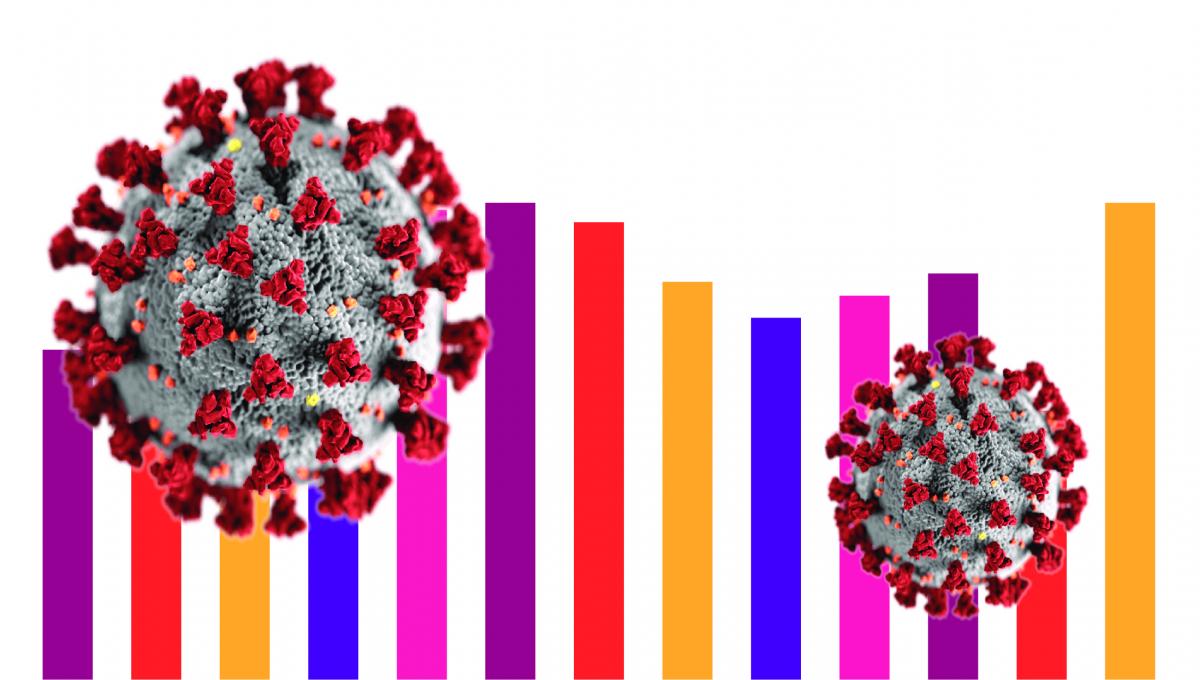
The impacts of the COVID-19 pandemic have been felt by scientists and scholars worldwide, as universities and industries have closed their campuses and standard funding and publishing pipelines have slowed down or shifted priorities. These impacts, however, are not felt equally by everyone; both institutions and individuals in developing countries often have fewer resources to support remote learning and working, and women often have different responsibilities that make working from home a bigger challenge than for men.
To get to the bottom of some of these differences and to understand the true impact of the pandemic on women scientists in developing countries, OWSD asked our network of members to tell us about how their work or studies, their family and home lives, and their mental wellbeing have been affected. The survey was conducted between June 16 and June 26, 2020. Some initial results from the survey are shared here; a full analysis will be published later.
Who were the respondents?
In total, 1,470 responses were received from women scientists in 85 countries; 18 responses were also collected from men, but these responses were excluded from the results here unless specifically indicated. The large majority of the respondents are primarily involved in either research (40%) or teaching (38%); another 10% are students, 4% working in administration, and 3% in industry (5% are not currently employed or are working in other areas).
More than half (57%) of respondents are working or studying at a public university; 12% are working at a governmental research organization/agency and 11% at a private university.
Close to a third (32%) of the respondents are in their early career; another 29% in their mid career, 21% advanced in their career, 13% students, and 5% retired or in another stage of their career.
Effects of COVID-19 on work and/or studies
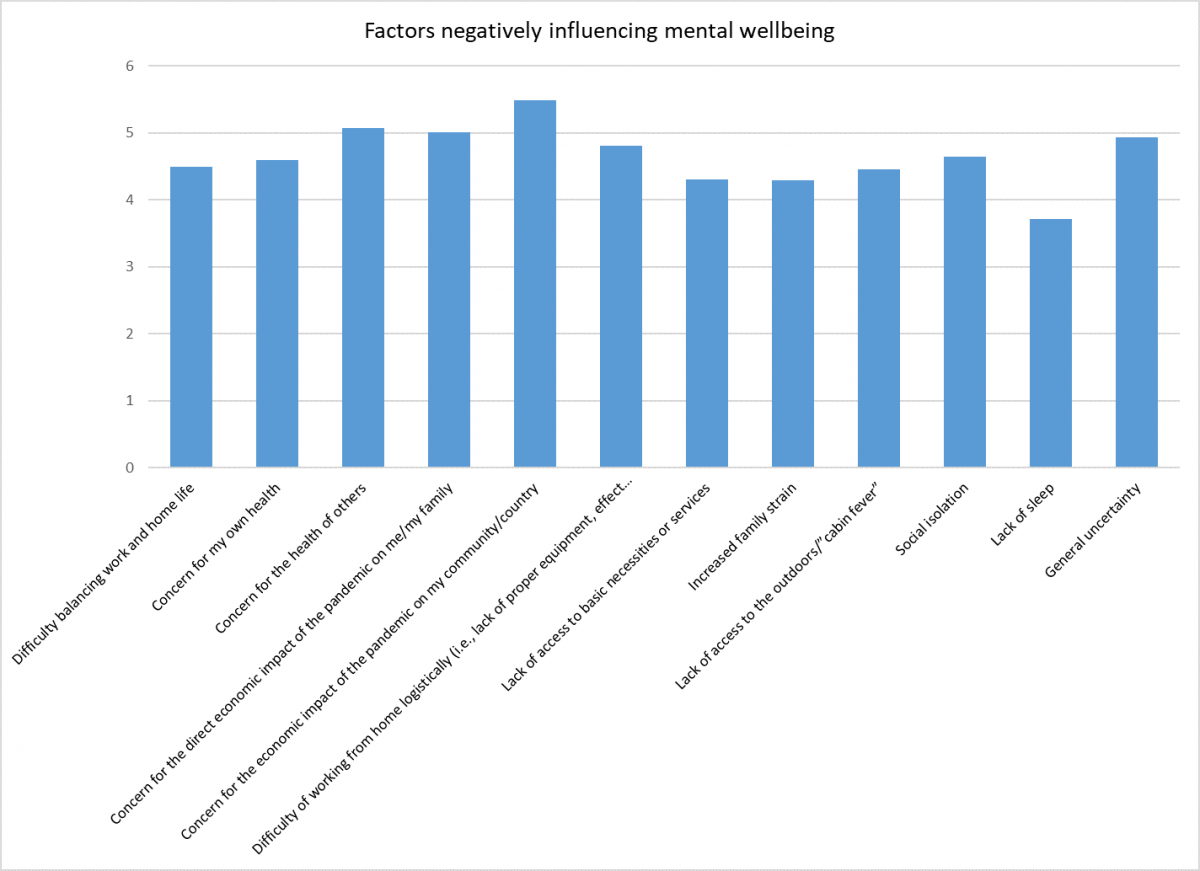
We wanted to find out how the pandemic has changed our members' work or studies - what challenges have they faced and what have been the consequences of those challenges, but also, what upsides have there been to the disruption in routine - and have they participated in a response to the pandemic themselves?
Negative effects
The most commonly cited negative impacts of the COVID-19 pandemic on work, research, or studies were: being unable to travel to conferences or other important work events (affecting 67% of respondents); being unable to perform experiments or field work (56%); being unable to provide teaching (31%); being unable to follow courses (22%); and the delay of pending publications (20%). Other negative impacts were the delay or suspension of ongoing funding (17%); difficulty finding collaborators (17%); being unable to submit funding proposals (16%); being unable to submit publications (14%); missing out on business opportunities or clients (13%); and being unable to take exams as scheduled (11%). Just under 5% of respondents also reported directly losing their employment as a result of the pandemic.
Of factors contributing to these effects, the most common were: inability to access the lab/office/necessary equipment/field work locations due to a lockdown (67%), reduced available working hours due to household or care responsibilities (44%); difficulty in effectively collaborating with colleagues (42%); lack of necessary equipment needed for effectively working or studying from home (42%); lack of a reliable internet connection to effectively work or study from home (41%); reduced access to teaching faculty and/or administrative staff (30%); and changes in institutional/departmental priorities (26%).
Positive effects
Alongside the negative impacts of the pandemic, many respondents also reported some positive outcomes. Most notably, 54% said that they have enjoyed more flexible working hours. Another 42% said that they have been able to expand their professional skills or experience; 27% have had more time available for their research; 26% said that their organization or institution has invested in new technologies for remote working/studying; 20% have had an opportunity to broaden their public engagement; and 19% have increased their scientific publications.
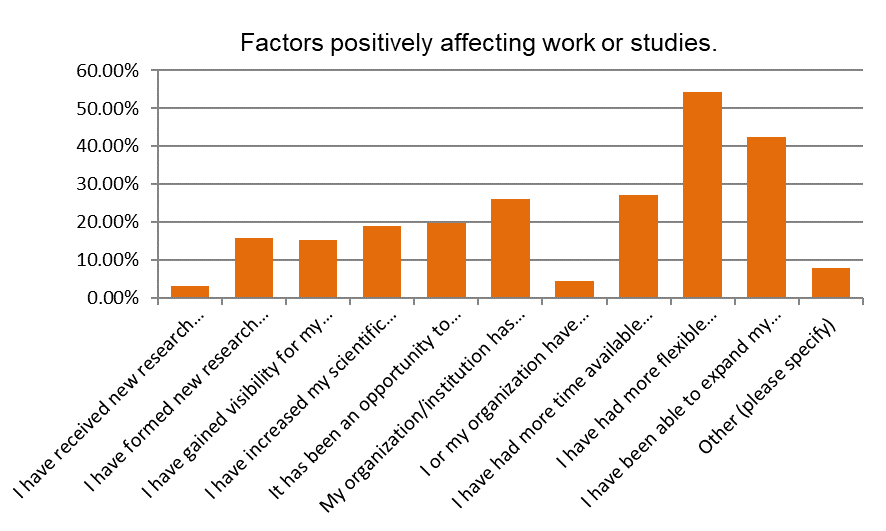
We also asked respondents to rate how prepared their institutions or organizations were for remote working/learning before the pandemic and how prepared they expect them to be afterward, from both a technological and an administrative perspective, on a scale of 0-5. The responses indicate that most scientists think their institutions will have improved in both areas following the pandemic; from an average technological preparedness score of 2.2 out of 5 to 3.3, and an administrative preparedness score rising from 2.1 to 3.2.
Involvement with a COVID-19 response
Many OWSD members were involved with some kind of response to COVID-19. Around 4% of respondents are performing research directly on the COVID-19 virus itself (including research on treatments or vaccines), while 14% are performing research on other effects of the pandemic (i.e. impact on other health conditions, societal or economic impact). A larger number (26%) are participating in raising awareness or disseminating information about the disease, and 8% are involved with coordinating policy response to COVID-19 at an institutional/organizational level.
Effects of COVID-19 on home and family life
Next, we asked our members to tell us how the pandemic has affected their lives at home and their family dynamics - have they had to devote more or less time to household chores and childcare? And again, what have been the upsides, if any?
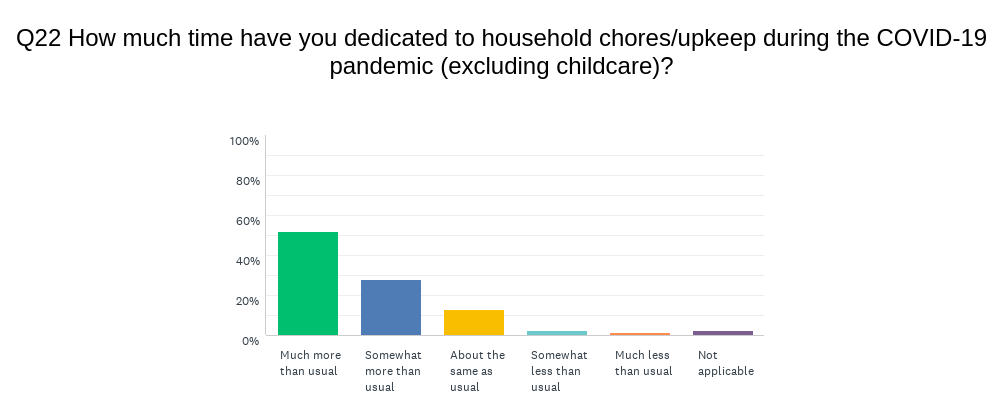 Time spent on household chores
Time spent on household chores
Over half of respondents (52%) reported spending much more time than usual on household chores during the pandemic, with 28% saying they spent somewhat more time than usual, 13% about the same, and around 4% either somewhat less or much less than usual. On average, respondents indicated that the share of household chores falling to them rose from 52% before the pandemic to 58% during.
Time spent on childcare and homeschooling
Of applicable respondents, a majority (61%) said that they spent much more time than usual on childcare during the pandemic; 24% said they spent somewhat more time, 12% about the same time, and fewer than 4% either somewhat less or much less than usual. On average, respondents indicated that the share of childcare falling to them rose from 51% before the pandemic to 66% during. They also reported being responsible for 69% of homeschooling required during the pandemic.
Positive outcomes
The most commonly reported positive outcome by far on OWSD members' home and family lives was having more time available to spend with their families, selected by 83% of respondents. Another 41% reported an improved relationship with their children, and 37% an improved relationship with their partner. Slightly less than a third (32%) said that they enjoyed being actively involved in their children’s education, while 29% say their children were able to mature and acquire greater responsibilities.
Effects of COVID-19 on mental wellbeing
Finally, we asked our members to report on how the pandemic has affected their mental wellbeing—how are they coping? More than a third said that the effect on their wellbeing has been mixed: in some ways positive; in some ways negative. Around a quarter (24%) said their wellbeing has been somewhat negatively impacted, while 10% said it has been severely impacted. Smaller numbers did report that their mental wellbeing has improved during the pandemic, with 6% each saying that it had improved either somewhat or significantly. For 18% of respondents, there has been no significant change to their mental wellbeing.
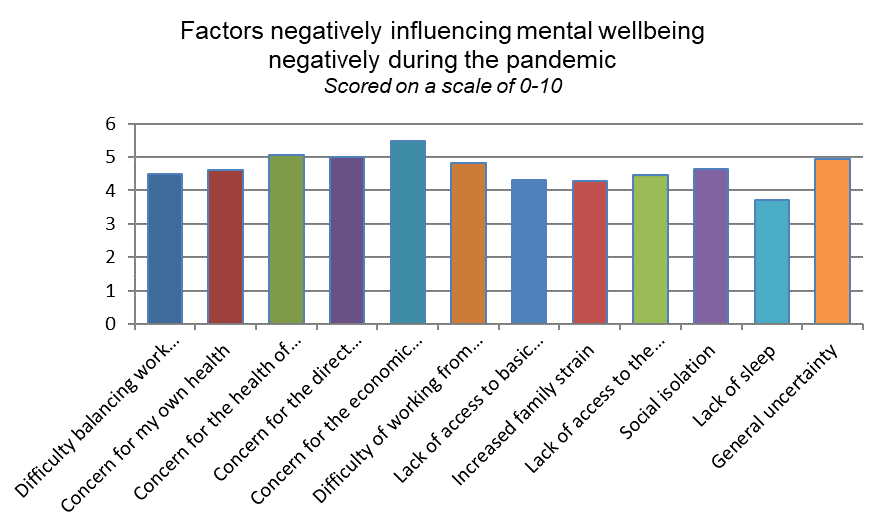 Negative factors
Negative factors
Respondents rated several factors potentially contributing to a negative impact on their mental wellbeing on a scale of 0-10. Of highest concern was the economic impact of the pandemic on respondents' communities/countries, with an average score of 5.49. Other top concerns were concern for the health of others (5.07), concern for the direct economic impact of the pandemic on themselves/their families (5.01), and general uncertainity (4.94). Additional concerns were the logistic difficulty of working from home (4.81), social isolation (4.64), concern for their own health (4.6), difficulty balancing work and home life (4.5), lack of access to the outdoors/”cabin fever” (4.46), lack of access to basic necessities or services (4.31), increased family strain (4.29), and lack of sleep (3.72).
Positive factors
Respondents also rated factors potentially contributing to a positive impact on their mental wellbeing, again on a scale of 0-10. Here again, more time available to spend with their families was by far the most signicant factor, with an average score of 7.66. More flexible working hours also scored highly, with 6.58 out of 10. More time available for self-care (i.e. getting more sleep, cooking better meals) was given an average rating of 6.67, while more time available for personal projects/hobbies was rated 6.37 and ability to connect with family/friends remotely using technology rated 6.33. Factors ranking slightly lower were a sense of solidarity or support from community (5.38), greater productivity working from home (5.2), and greater recognition and appreciation for their work/research (4.92).
